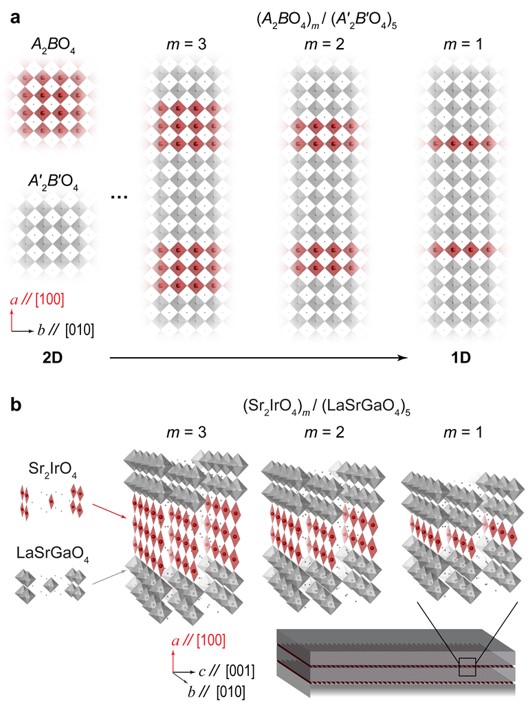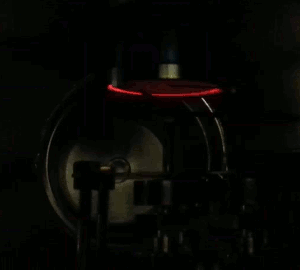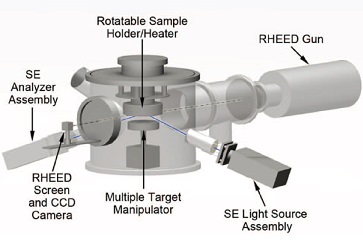We are enthusiastic
about investigating the properties of materials with strong
electron-correlation and spin-orbit interaction. This motivation
is related to the history of condensed matter physics. There have
been several paradigm shifts concerning our understanding of the state
of matter. The state of matter was initially thought to be
governed by its building blocks (i.e., atoms)
and how these building blocks are bonded to one another (i.e., crystal
structures). However, many properties of materials were found to
change 'spontaneously' as external conditions or parameters (e.g.,
temperature, magnetic field, pressure, etc.) were varied – even if the
structures and atoms remained the same. These phenomena were
termed 'phase transitions.'
Since their discovery, novel concepts related to phase transitions such
as spontaneous symmetry breaking and order parameters were established.
We are currently
witnessing another paradigm shift,
ushering in a new era of condensed matter physics. The discovery
of the quantum Hall effect in two-dimensional electron systems has led
to the new idea that the state of matter is governed by not only
crystal structure or symmetry but also the presence of topological invariants.
This means that the quantum wavefunctions are tied in a knot. For
example, the phase of a superconducting wavefunction varies smoothly
from place to place, but in making a circuit around a ring it may end
up different by a multiple of 2π. These different states of the
superconductor carry different currents and are robust against external
disturbance. Moreover, the topological invariants can be broken
at points or lines, which can bring about new collective excitations
(i.e., quasi-particles), leading to new physical properties. Such
topologically-protected states of matter can provide a pathway to many
useful device applications. Hence, the topological properties of
matter are attracting attention not only in the condensed matter
physics community but also in other areas of science and engineering.
Recent studies on 4d and 5d transition-metal oxide (TMO)
crystals have revealed
novel ground states resulting from the interplay
between strong electron-correlation and the relativistic spin-orbit
interaction. Such strong spin-orbit coupling is also believed to
provide topologically-protected novel electronic states, leading to an
exciting new field of condensed matter physics. Therefore, the
unique
circumstance of coexisting strong electron-correlation and spin-orbit
coupling in 4d and 5d TMOs has attracted enormous
interest in these compounds.
1. Why do we study thin-films and heterostructures?
There has been much experimental work dedicated to
finding topological phenomena in oxide crystals including ruthenates
and iridates. However, topological properties have not been
clearly observed due to correlation-induced magnetic ordering and
fully-gapped insulating ground states. We have noted that the
topological invariant of a system is governed by two essential
ingredients, the dimensionality
and the symmetry of the
system. In one or two dimensions, unwanted magnetic ordering can
be suppressed by enhanced quantum
fluctuation
of the order parameters, making hidden topological states
visible. Hence, if we can increase the quantum fluctuation of a
system by lowering its dimensionality or changing its symmetry, the
hidden nontrivial topological states may emerge. Our approach is
to make model low-dimensional systems from thin films. This
protocol offers further benefits of tunability for controlling the
dimensionality, the lattice-symmetry (by strain), and the interfacial
interactions. Tuning these parameters is expected to compel
strongly interacting electrons in complex oxides to exhibit
unprecedented exotic collective states. Moreover, since
topological materials undergo phase transitions as these parameters are
varied, the tunability of this approach offers capabilities to fully
investigate the phase diagrams of topological states.
2. One-dimensional
quantum-stripe superlattices
We developed a new
approach for controlling the dimensionality of
complex oxide superlattices between one dimension (1D) and two
dimension (2D),which offers a new direction of oxide quantum materials. As
a prototype material, we have found that one dimensional (1D)
structural and electronic confinement can be experimentally achieved
for iridate superlattice systems, as shown in figure. This
superlattice method can be extended to any two dimensional (2D) layered
material and thereby allows for tunability between 1D and 2D. See
Advanced Materials 29, 163798
(2017) for details.
[Figure]
Schematic diagrams of turning a 2D layered material into a 1D quantum
stripe superlattice.
a)
The leftmost panel shows the in-plane structures of two
transition-metal oxides, A2BO4 (top) and A'2B'O4
(bottom), with the
K2NiF4 symmetry. Each red (gray) square contains transition-metal ions
B (B') at its center and an oxygen atom at each of its four vertices.
b) Schematic diagrams of a-axis-oriented
(Sr2IrO4)m/(LaSrGaO4)5
superlattices for m = 3, m = 2, and m = 1 for
realizing the low-dimensional quantum stripes of IrO2 (red
squares) on
LaSrGaO4 (100) substrates. The 1D IrO2 stripes
run parallel to the
b-axis and
are dimensionally confined by the wide-bandgap LaSrGaO4
layers (grey octahedra).
|
 |
3. In-situ,
real-time spectroscopic ellipsometry on complex oxide heterostructures
We have developed a pulsed laser deposition (PLD) system
with dual in-situ
capabilities for optical spectroscopic ellipsometry and reflection
high-energy electron diffraction (RHEED). Spectroscopic
ellipsometry uses a range of photon energies from 1.2 eV – 6.0 eV (1000
nm – 210 nm in wavelength). This spectral range allows us to
monitor the real and imaginary dielectric functions of thin films and
heterostructures in real time, which greatly complements the structural
information obtained by RHEED (see Review of Scientific Instruments 84,
043902 (2013) for technical details). The dual in-situ monitoring
of both spectroscopic ellipsometry and RHEED provides considerable
freedom since the former is not restricted by the growth conditions,
whereas the latter has a limited operational range of background gas
pressures.
Equipment
|
Pulsed Laser Deposition
(Laser-MBE) Chamber 1 ("Rocky")
Custom-made, Rocky Mountain Vacuum Tech.
|
|

|
- Compatible design with in-situ Optical
Spectroscopic Ellipsometer and in-situ Reflection High-Energy Electron
Diffraction
- Rotational radiation heater (Max. Temp. 950 C)
- Multiple-target (4) manipulator
- Mass flow controllers with an automatic
feedback throttle valve
- Vacuum gauges, Turbo-molecular pump &
rotary pump
|
|
Pulsed Laser Deposition Chamber 2 ("JJ")
Home-made
|
|

|

- Multiple-purpose convertible chamber
- Fixed high oxygen pressure heater with precious
metal element (Max. Temp. 1100 C in O2)
- Home-made multiple-target (4) manipulator
- Vacuum gauges, Turbo-molecular pump &
rotary pump
|
|
KrF (248 nm) Excimer Pulsed Laser System
LightMachinery IPEX-860 & Home-made optics
|
|

|
- Wavelength: 248 nm
- Max. Energy: 600 mJ
- Max. Frequency: 50 Hz
- Pulse-width: < 20 ns
|
|
In-situ Reflection High-Energy Electron Diffraction (RHEED)
Staib RHEED system & Home-made software
|
|

|
- E-beam energy : 0 - 30 kV
- Differential pumping port
- Home-made RHEED monitoring software (Labview)
|
|
In-situ & ex-situ Optical Spectroscopic Ellipsometer (SE)
Woollam M-2000X-210 In-Situ SE
|
|


|
- Automatic ex-situ stage
- Spectral range : 1.2 eV - 6 eV
- Ex-site Variable Angle Stage included


|
|
Sample Annealing Furnaces
Thermolyne Benchtop Muffle furnaces
|
|

|
- Max. temperature: 1150 C
- Programmable
|
|
NIR-VIS-UV Optical Spectrometer
Perkin-Elmer Lambda-950
|
|

|
- Photon energy range: 0.4 - 7 eV
- Transmittance optics
- Absolute Reflectance optics
- Home-made low-temperature optics,
cryostat adapter, and stage
|
|
Low-Temperature Optical Cryostat
Oxford Instruments Optistat CF
|
|

|
- He flow-type low-temperature cryostat
- Temp. Range : 3.4 - 320 K
- Compatible with Perkin-Elmer Lambda-950
- Compatible with our home-made transport
measurement system
|
|
Atomic Force Microscope
Park systems XE-70
|
|

|
- Decoupled xy and z motions
- Measurement Options: AFM, CFM, PFM, LFM, etc.
- Home-made mobile stage
|
|
Optical Cryostat Magnet
Oxford Spectromag. 4000
|
|

|
|

Internal User Facilities
|
Links
Condensed
Matter Group @ UKY
Center for Nanoscale Science and Engineering
|


















